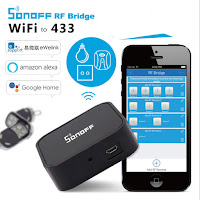After installing an electric gate opener for my driveway, I decided that I did not want to have to always carry around the remote control. Setting up a keypad or RFID reader was an option, but it would require a lot of digging, setting a post, running wires, and it would not be cheap. What I really wanted was a way to open the gate (using the gate controller's external button switch connections) from my iPhone. The gate is far enough away from my house that a WiFi connected relay was not an option. Also, I did not want to have to install and use some proprietary app just to push the button. That narrowed down the requirements to a HomeKit compatible Bluetooth relay. Unfortunately, I could not find any general relays for Homekit that used Bluetooth (Apple's MFi is not very DIY friendly).
Enter the SYLVANIA SMART+ Bluetooth Outlet, compatible with Alexa, Apple HomeKit, and Google Assistant, currently available for a bargain $6.99 on Amazon. It makes a lot of sense to use in locations where you don't have WiFi, or just can't use the WiFi you have access to (like in an office). Of course, this is not a general purpose relay, and I don't need a switched 120V outlet. But, I expected that it was just a relay inside and I hoped it could be easily disconnected from the mains electricity and instead connected to switch low voltage.
When the outlet arrived, I followed the directions, briefly installed the Sylvania App (which did not require me to create an account!), updated the firmware, and had it running in HomeKit within a few minutes. I then deleted the Sylvania App and still had complete control of the outlet from my iPhone Control Center. Now for the fun part!
The outlet's PVC cover seemed quite well bonded together so I pulled out the hacksaw to cut it open around the perimeter of the enclosure near the back.
With the board liberated from its enclosure, it was quite easy to see how the relay (data sheet) was connected to switch the hot side, connecting the plug to the outlet when activated. I desoldered the two plug receptacles for the hot and neutral sides of the outlet. This also separated the Common terminal of the relay from the outlet. Then, i needed to separate the Normally-Open side of the relay from the plug. I used the edge of a small file to cut through the solder and copper on both sides of the board until I was through to beige PCB material all the way across the trace. There are a lot of tiny vias in this trace, so it is important to double-check it with a magnifying glass and verify that there is infinite resistance between the relay terminal and the hot plug prong.
Next I soldered a wire to the relay Common terminal, and another to Normally-Open terminal. I connected these wires to a 5v power source with a current-limiting resistor and an LED. I carefully plugged this contraption back into an outlet, and... the iPhone HomeKit button worked perfectly to control the low voltage and LED!

|
|

|
Since I was pretty careful opening everything up, it will not be too hard to glue the enclosure back together with some PVC cement so that it can be used safely. In the meantime, I routed the wires out of the hole for the outlet's ground, added some spade terminals, and taped the cover back on.
I was really happy with how simple and cheap this project was and that it worked perfectly the first time. The modified Sylvania HOME+ Bluetooth outlet will make a great HomeKit relay for projects not in WiFi range. Here is the final install in my gate opener controller box, connected to the external button switch terminals:










